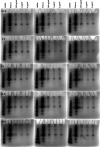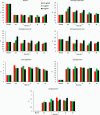Protein Corona Composition of Gold Nanocatalysts
- PMID: 38633595
- PMCID: PMC11020068
- DOI: 10.1021/acsptsci.4c00028
Protein Corona Composition of Gold Nanocatalysts
Abstract
The interaction between nanoparticles (NPs) and biological environments is profoundly influenced by a stable, strongly adsorbed "hard" protein corona. This corona significantly determines the NPs' pharmacokinetics and biological destiny. Our study delves into the mechanisms by which colloidal Au nanocrystals that are synthesized electrochemically without surface-capping organic ligands, known as CNM-Au8, traverse the blood-brain barrier (BBB) and target human brain tissue for treating neurodegenerative disorders. We discovered that upon interaction with human plasma, CNM-Au8 gold nanocrystals (AuNCs) effectively attract a variety of crucial apolipoproteins, notably apolipoproteins E, to their surfaces. This interaction likely facilitates their passage through the BBB. Furthermore, the coronas of these AuNCs exhibit a substantial presence of albumin and a notable absence of opsonin-based proteins, contributing to prolonged blood circulation. These characteristics align well with the clinical performance observed for the CNM-Au8 NCs. This study highlights that AuNCs with intentionally engineered structures and surfactant-free surfaces can create a distinct protein corona composition. This finding holds significant promise for the development of advanced therapeutic agents aimed at combating neurodegenerative diseases.
© 2024 The Authors. Published by American Chemical Society.
Conflict of interest statement
The authors declare the following competing financial interest(s): Morteza Mahmoudi discloses that (i) he is a co-founder and director of the Academic Parity Movement (www.paritymovement.org), a non-profit organization dedicated to addressing academic discrimination, violence and incivility; (ii) he is a co-founder of Targets Tip; and (iii) he receives royalties/honoraria for his published books, plenary lectures, and licensed patent. Michael Hotchkin, Adam Dorfman, and Karen Ho disclose that they are full-time employees of Clene Nanomedicine and receive salary and stock options as such. Karen Ho discloses that she serves as a paid consultant/Scientific Advisor to FamilieSCN2A Foundation.
Figures





Similar articles
-
A Mechanism Underpinning the Bioenergetic Metabolism-Regulating Function of Gold Nanocatalysts.Small. 2024 Feb;20(8):e2304082. doi: 10.1002/smll.202304082. Epub 2023 Sep 28. Small. 2024. PMID: 37767608
-
A model beyond protein corona: thermodynamics and binding stoichiometries of the interactions between ultrasmall gold nanoclusters and proteins.Nanoscale. 2020 Feb 21;12(7):4573-4585. doi: 10.1039/c9nr09170j. Epub 2020 Feb 11. Nanoscale. 2020. PMID: 32043104
-
Study of Hard Protein Corona on Lipid Surface of Composite Nanoconstruction.Nanomaterials (Basel). 2024 Nov 4;14(21):1767. doi: 10.3390/nano14211767. Nanomaterials (Basel). 2024. PMID: 39513847 Free PMC article.
-
The Evolving Use of Gold Nanoparticles as a Possible Reversal Agent for the Symptoms of Neurodegenerative Diseases: A Narrative Review.Cureus. 2024 Jul 18;16(7):e64846. doi: 10.7759/cureus.64846. eCollection 2024 Jul. Cureus. 2024. PMID: 39156432 Free PMC article. Review.
-
How protein coronas determine the fate of engineered nanoparticles in biological environment.Arh Hig Rada Toksikol. 2017 Dec 20;68(4):245-253. doi: 10.1515/aiht-2017-68-3054. Arh Hig Rada Toksikol. 2017. PMID: 29337683 Review.
Cited by
-
Accelerated Nanocomposite Hydrogel Gelation Times Independent of Gold Nanoparticle Ligand Functionality.ACS Omega. 2024 Oct 14;9(42):42858-42867. doi: 10.1021/acsomega.4c05102. eCollection 2024 Oct 22. ACS Omega. 2024. PMID: 39464430 Free PMC article.
-
The Photomodification Method Allows for Determining the Composition of the Full and Soft Protein Corona on the Lipid Surface of Composite Nanoparticles.Nanomaterials (Basel). 2024 Dec 9;14(23):1976. doi: 10.3390/nano14231976. Nanomaterials (Basel). 2024. PMID: 39683364 Free PMC article.
-
Small molecule modulation of protein corona for deep plasma proteome profiling.Nat Commun. 2024 Nov 7;15(1):9638. doi: 10.1038/s41467-024-53966-z. Nat Commun. 2024. PMID: 39511193 Free PMC article.
-
Deep Plasma Proteome Profiling by Modulating Single Nanoparticle Protein Corona with Small Molecules.bioRxiv [Preprint]. 2024 Sep 9:2024.03.06.582595. doi: 10.1101/2024.03.06.582595. bioRxiv. 2024. PMID: 38496642 Free PMC article. Preprint.
-
Blueprint of Collapse: Precision Biomarkers, Molecular Cascades, and the Engineered Decline of Fast-Progressing ALS.Int J Mol Sci. 2025 Aug 21;26(16):8072. doi: 10.3390/ijms26168072. Int J Mol Sci. 2025. PMID: 40869392 Free PMC article. Review.
References
LinkOut - more resources
Full Text Sources
